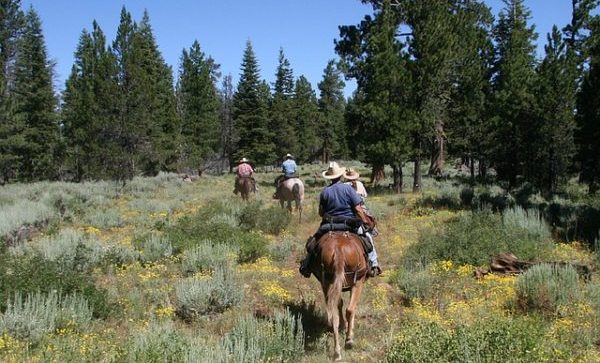Most horses and their riders enjoy a relaxing ride out on the trails. Good trails are a privilege, and how we treat them can make a big difference to their sustainability.
Here’s an equine wellness aspect you may not have considered – the condition of your horse trails! A poorly designed or maintained trail can lead to that most dreaded of situations: denial of equine access.
In order to remain available to horseback riders, trails need respectful treatment. From design to maintenance, concept to long-term preservation, careful thought and action are paramount so that equestrians can preserve their access to riding trails.
In order to remain available to horseback riders, trails need respectful treatment.
The relationships you have with landowners and managers also need to be nurtured and maintained. Lack of respect for these relationships will likely lead to angry landowners, and that can result in closed trails.
Things to think about
- Whether public or private, trail landowners and managers have a stake in the value and condition of their land. Trail abuse by equestrians makes them very unhappy.
- Landowners and managers are always concerned about liability. A lack of understanding about liability protections can prevent a trail from ever being built, or close an existing one. For more information on liability, see elcr.org/assurethereluctantlandowner/.
- Horses are tough on land. The torque of pointy feet leads to churned soil and plants, creating conditions for erosion.
- Storm water runoff makes trail erosion possible. Once erosion starts, it needs to be corrected quickly. Clay soils are especially prone to erosion.
- Rider behavior on the trail can result in enjoyable outings – or it can undermine trail owner/manager relations. Contributing to erosion by riding off the trail, riding in wet weather conditions, leaving trash behind, not watching out for other users, and not reporting trail damage are examples of bad rider behavior.
- Community planners make decisions about land use in your trail areas. In fact, they probably already have. Research current and future decisions that may affect your trail access. Without this knowledge, you may miss the chance to prevent trail closings and to help guide recreational and equine accessible trail planning to your community. For more information on what to be aware of, check out elcr.org/three-words-every-equestrian-should-know/.
- The combination of bad rider behavior, poor landowner/manager relations, degraded trail conditions and uninformed equestrians will eventually result in loss of trail access.
Preserving equine trail access
Existing trails
Seven steps to preserve existing trail access:
- Start with assessing the condition of existing trails. Are they too steep? Do they have ruts that make people ride outside the trail edges? Are surfaces washed away? Is soil and plant loss contributing to erosion? Are stream crossings too dispersed, or stream banks eroded? If any of these conditions are seen, talk to the landowner or manager about improving trail alignments and slope conditions. A professional trail designer can help create an improvement plan and/or make the needed trail changes.
- Initiate a riding club or organization if you don’t belong to one already. See elcr.org/successful-trail-organization-models-to-protect-endangered-trails-2/ for tips on creating an organization. This will give you several advantages:
- An advocacy group for your trail needs
- Identified leaders who will drive action
- A regular source of information
- Planning capabilities
- Help for developing rules for trail behavior
- A resource for riders facing new or recurring trail challenges
- Reach out to landowners and managers! Develop friendly relationships and work to keep them. Help private landowners understand liability protection through state recreational liability laws and liability insurance, which may be provided by your riding club through group or individual policies.
- Learn about easements. Educate your club or organization members. Approach private landowners about creating a trail easement across their property. This will help assure long-term access and connectivity in your trail system.
- Participate in the community planning process through your local planning or town council office. Comprehensive plans express how the community wants land to be used in the future. Learn how your community’s plan addresses equestrian uses. Ask if an equestrian trails plan can be added to the comprehensive plan, or if an existing plan can be adjusted to include your specific trail needs.
- Create a set of trail user rules and regulations. Use riding liability waivers. Limit access if that is needed or required. Get to know and cooperate with other users, if any, to avoid conflicts.
- Volunteer for trail maintenance activities! This is good for safety, owner/manager relationships, and reducing costs for needed improvements.
Volunteer for trail maintenance activities! This is good for safety, owner/manager relationships, and reducing costs for needed improvements.
New trails
Seven steps for developing new trails – starting with your own land:
- Create a trails plan. Consider soil conditions, vegetation, wetlands, streams and ponds, slopes, etc. A professional can help design your trail alignment surface.
- Look for funding. Sources may include farm/equine operation income, loans, donated materials and volunteer labor. Can you derive income from your trail? See org/finding-funds-for-your-private-land-trails/ for more information on possible funding.
- Check your own liability insurance. Research your state’s recreational liability laws.
- Look for outside trail connections, including adjacent parks, trail easements, open fields and roadways. Get permission to traverse these areas and check them for safety and condition.
- Familiarize yourself with community land use plans. (See point 5 under Existing Trails).
- Develop good relationships with adjacent landowners or managers, especially if you are looking to connect your trail to their land.
- Pursue easements for private land trails. You should work with a land use attorney specializing in trail easements.
Having nice trails to use is important to many equestrians. By building and maintaining good relationships with landowners, respecting the trails, and pitching in to maintain and create new trail systems, we can ensure that we have lovely, safe equestrian trails for years to come!







